From shooting practice to dog work, good eating and getting new hunters into the field, dove hunting is the perfect upland warm-up for fall
Story by Rich MasseyPhotos by Will Massey
As a kid in the 60s, living on the prairie in small-town Minnesota, we made our own fun. Being in the company of other boys who loved bird hunting, we didn’t stop enjoying our passion just because it wasn’t waterfowl or pheasant season.
No matter what time of the year it was, to hunt pigeons. We learned to hunt wheat fields because that was where the birds were. Not just pigeons but mourning doves. Lots of mourning doves. Of course, mourning doves were about 30 years away from being legal quarry then. But the lessons learned in those long-ago halcyon days of my youth taught me many things that made me a better dove hunter today.
Now, even here in the North, we have that opportunity to bring a kid or young dog to the dove fields and teach those same lessons. Dove season will sharpen the hunting skills of all hunters … ones new to the magic, and even old-timers like me.
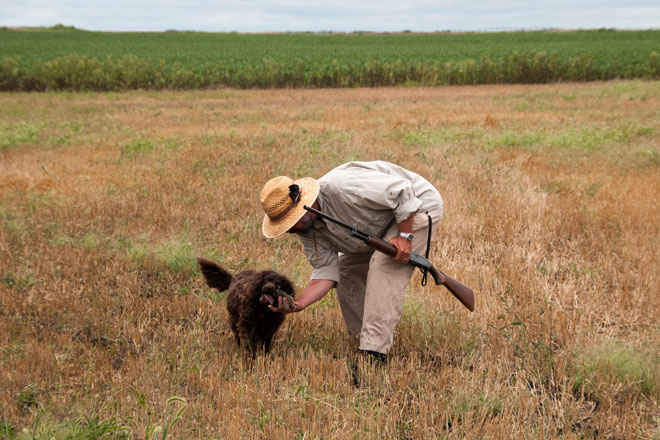
In my 70s now, I am still a rabid hunter and I love to get out to the wheat fields to start the fall each year. The secret to hunting mourning doves, as with every species of game, is scouting. I cruise the backroads each August searching for wheat fields. That is often the key to the action dove hunters are looking for.
That may sound easy, but it’s not. Wheat fields in our area, and perhaps in yours, are scarce as hen’s teeth these days. Here’s where I must give a shout out to the Department of Natural Resources (DNR) in Minnesota. They have provided a number of wheat fields in our area on state lands that are open to public hunting.
Another state that manages some areas especially for dove hunters is Iowa. Sunflower fields are often the grain of choice there. Like wheat fields, sunflower fields are always dove magnets.
Decoys with spinning wings bring the birds closer as they wing on by. As a pheasant hunter, I use the dove hunting opportunity to train my dog to remain firmly by my side while we are posting. Then with luck and a bit of shooting kill on my part, he will be sent to fetch the downed bird.
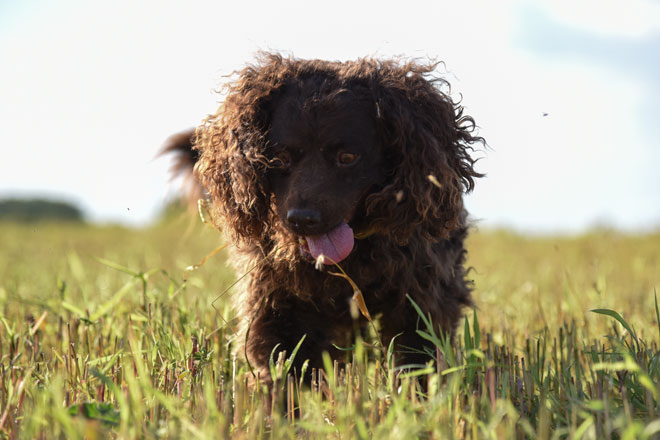
Speaking of skill, most pheasant hunters have a problem shot that causes them trouble. Is it a left to right crossing shot? Is it a straight overhead shot? Whatever it may be, dove hunting is your opportunity to work that out before a big fat rooster makes a monkey out of you in the pheasant fields later in the fall.
And imagine the usefulness of this hunt if you have a young hunter to mentor. The dove season is priceless for that.
Wheat is harvested before dove season and as we start things off, the remaining stubble isn’t too tall. That’s a plus for a young dog that needs retriever training. That’s great. But there’s more.
Usually, as a week goes by in the dove season, the cut wheat begins to sprout and greens up into about half-foot-high swaths of cover. That extra six inches or so hides feeding birds and gives the pheasant hunter yet another opportunity to practice his craft.
I have a friend who is a pheasant fanatic and can’t sit still. He can’t stand to sit on a pail in the stubble and shoot at passing birds. But he does show up when the aforementioned sprouting has occurred.
To simulate his favorite form of hunting, he and his springer will wander the wheat field, jump- shooting the feeding doves. That activity is close enough to his beloved pheasant hunting to satisfy his inborn need to be constantly on the move.
I love having my friend along because he is constantly pushing the birds around, which gives me more shooting. The regrowth hides the doves so the dog can get up on them for the flush. Believe me, after a run at the doves, my friend’s shooting reflexes are ready for the pheasant season.
I have hunted mourning doves since the Minnesota dove season’s inception in 2004. One secret I’ve learned surprises some people: I always find a standing cornfield to set up next to. There are two reasons.
First, when the doves are in our area during their migration, any time of the day could be good for hunting. By observation, I found that birds were flying into and out of standing cornfields. After seeing this enough times, I began to focus on setting up somewhere that the birds were trading back and forth from. It makes sense when you realize how nice the shade in that cornfield is for those doves.
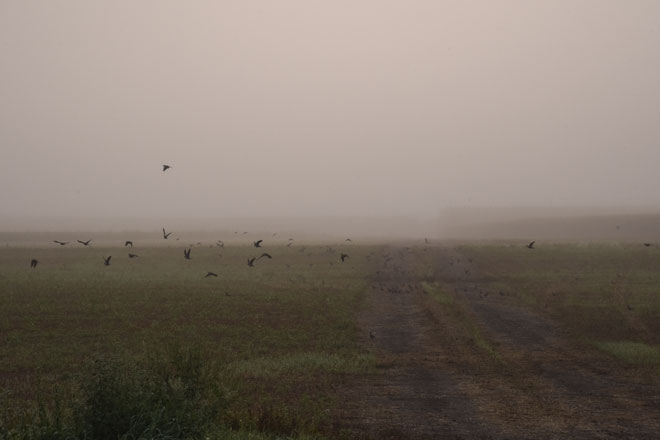
Second, many times upon opening the dove’s crop, you will find tiny black weed seeds: like the weeds that grow between the rows in a standing corn field.
Speaking of crops, tiny pieces of grit must be ingested by the doves to use their crop to grind their food. Know where the grit is and you have another trick for finding doves.
Where will you find the best grit? In a gravel pit. Many is the time I have gone to a local pit that has been abandoned, to shoot doves. Abandoned pits can be easy places on which to secure hunting permission. At sundown, the gunning becomes hot.
Many pits are abandoned because the digging has hit water. That gives the doves another reason to go there. As an added bonus: After the shooting is done, I can eviscerate my birds and clean the breasts in the water before adding them to a zip lock bag for a trip to the refrigerator and a nice soak in salt water to draw the blood out.
Mourning doves are easy to clean. Rip into the skin beneath the breastbone. Pull up to expose the two tendons holding the breast to the bird’s body. Snip the breast free with your game shears. Simple pimple.
One day afield, during the first dove season after I had eaten my first legal mourning doves the night before, I was transported back to my boyhood days when Patsy Cline was just starting to sing “Crazy “on the jukebox.
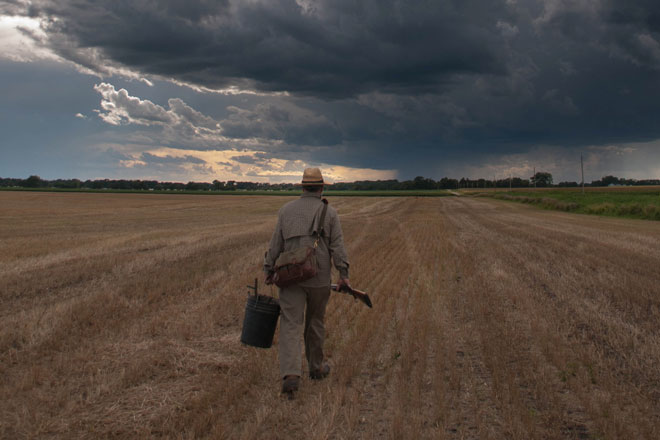.jpg.aspx)
In those long-gone days, we young lads sat on pails in the wheat fields just as I do today. It was pigeons we were after then. We used a large spread of decoys: We’d open a package of colored napkins and spread them around the field to mimic the multi colors of a feeding flock. It worked like a charm. Then with our birds, we’d head for the shade of a nearby river where we’d nosh on those birds. Pretty tough meat, I recall.
But mourning doves … now there’s some toothsome eating. “Tender as a widow’s heart,” remarked a friend after eating a number of dove breasts with a slice of green pepper wrapped in bacon that came off my barbecue grill.
Concerning guns and ammo, the equation I have arrived at is this: I use a 12 gauge because you can get low base trap shells relatively cheaply. Hopefully you will need a lot of them, because that means the birds are in. With a 15-bird daily limit you can burn through a lot of shells. Check your local regulations for your limit.
I recommend improved cylinder for choke. Many shots will be close and those that are not will do the job as a dove can be dropped fairly easily at range. I had my Model 12 Winchester bored out to improved cylinder for use in the dove field. It was originally full choke as most of them were, but that just won’t do for doves.
We all hope the younger generations will embrace hunting as we did, and help us pay the conservation bills. I am heartened by the advent of the high school trap leagues. And the girls are getting involved. That is excellent!
But parents and mentors can do even more. They can introduce those same youths to dove hunting. It just makes sense. The season begins September 1 in my state. Check yours. Nice warm weather that won’t be off-putting like what comes later.
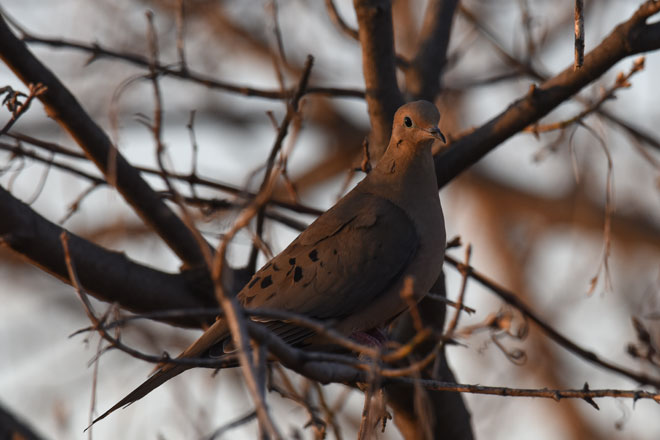
More benefits?
There is no need to get out there in the too-early dark when teens like to sleep in on the weekends.
The newbies can even use the same guns and ammo they’re already used to from trap league. Plus, they will learn skills of when to mount the gun so as not to spook the approaching dove.
And as a parent or mentor, dove hunting will be a perfect time to observe the young or new gunner for gun safety in the field.
Finally, for new and experienced hunters alike, there is the pride of providing a delicious meal for the family with your gun.
What could be better than that? It’s as American as apple pie.
From spearing pike in the depths of winter to hunting the doves of late summer, Richard Massey keeps busy hunting and fishing every month of the year on the prairies of western Minnesota. His son Will serves as talented cameraman on many of the adventures.